
Eucalyptus pauciflora, commonly known as snow gum, cabbage gum or white sally, is a species of tree or mallee that is native to eastern Australia. It has smooth bark, lance-shaped to elliptical leaves, flower buds in clusters of between seven and fifteen, white flowers and cup-shaped, conical or hemispherical fruit. It is widespread and locally common in woodland in cold sites above 700 m (2,300 ft) altitude.
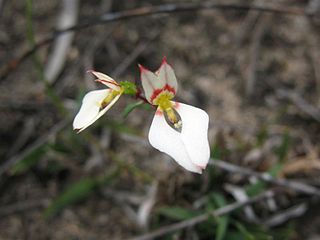
Levenhookia pauciflora, the deceptive stylewort, is a dicotyledonous plant that belongs to the genus Levenhookia. It is an ephemeral annual that grows from 5–10 centimetres (2.0–3.9 in) tall with ovate to suborbicular leaves. Flowers are white and bloom from September to November in its native range. L. pauciflora is endemic to Western Australia where it grows in sandy soils in sandstone or granitic areas. The flowers of L. pauciflora resemble those of Stylidium ecorne and it has been said that S. ecorne mimics L. pauciflora to take advantage of its pollinators.
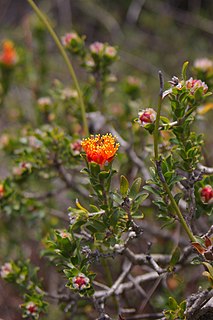
Eremaea is a genus of woody shrubs and small trees in the family Myrtaceae and is endemic to the south-west of Western Australia. Little study of the genus as a whole had been undertaken until Roger Hnatiuk researched Eremaea and published a paper in 1993, A revision of the genus Eremaea (Myrtaceae) in Nuytsia. The first species to be described was Eremaea pauciflora in 1837 and by 1964, the number of species known had increased to 12. Hnatiuk recognised 16 species, 5 subspecies and a number of varieties.

Frankenia pauciflora, the common sea-heath or southern sea-heath, is an evergreen shrub native to southern Australia. It is part of the Frankenia genus of the Frankeniaceae family.
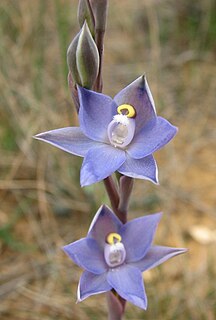
Thelymitra pauciflora, commonly called the slender sun orchid in Australia and maikaika or maika in New Zealand is a species of orchid in the family Orchidaceae. It is one of the most widespread and common orchid species in Australia, growing in all states except Western Australia and the Northern Territory, and also in New Zealand including Chatham Island.

Eremaea pauciflora is a plant in the myrtle family, Myrtaceae and is endemic to the south-west of Western Australia. It is a shrub with small leaves and orange flowers at the ends of its branches. It has the most widespread distribution of the eremaeas with considerable variation in its characteristics so that three varieties are recognised. It was the first Eremaea to be described formally but was not originally given the name Eremaea.

Persoonia pauciflora, commonly known as the North Rothbury persoonia, is a plant in the family Proteaceae and is endemic to a small area of New South Wales. It is a small, spreading shrub with bright green, thread-like leaves and a relatively small number of yellow flowers in summer. A recently described species, it is similar to P. isophylla but has fewer and shorter flowers than that species. A very restricted distribution has led to its classification as "critically endangered" under the Australian Government Environment Protection and Biodiversity Conservation Act 1999.
North Rothbury is a small town located in the Hunter Region of New South Wales, Australia. It is 19 km from Cessnock. In the 2016 Australian Census the suburb was home to 898 people.

Cap Island Conservation Park is a protected area in the Australian state of South Australia located about 7.5 kilometres (4.7 mi) offshore, west of Mount Misery, Eyre Peninsula. The park covers Cap Island's 8ha surface. The island consists of a granite base and a calcarenite mantle; its margins steeply over-hanging and eroded. Typical vegetation is a low Nitre Bush shrubland. Cap Island Conservation Park was constituted by statute in 1972 to conserve a sea bird breeding area and Australian Sea-lion and New Zealand Fur-seal haul-out areas.

Melaleuca pauciflora is a shrub in the myrtle family Myrtaceae, endemic to the south-west of Western Australia. Its decussate leaf arrangement and its small heads of white flowers on the sides of its branches are diagnostic. This is probably the least spectacular of all the melaleucas.
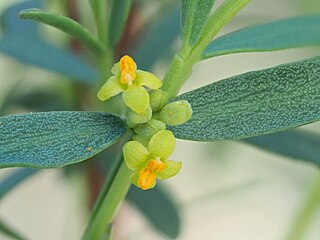
Pimelea pauciflora, commonly known as poison rice-flower, is a species of shrub in the family Thymelaeaceae. It has small yellow-lime flowers, green, smooth fleshy leaves and is endemic to Eastern Australia.
Grevillea pauciflora, commonly known as the few-flowered grevillea, is a shrub of the genus Grevillea native to an area along the south coast in the Great Southern and Goldfields-Esperance regions of Western Australia.
Grevillea sparsiflora, commonly known as the sparse flowered grevillea, is a shrub of the genus Grevillea native to an area along the south coast in the Goldfields-Esperance regions of Western Australia.

Kunzea pauciflora, the Mount Melville kunzea, is a species of flowering plant in the myrtle family Myrtaceae, and is endemic to a small area on the south coast of Western Australia. It is a shrub with the stems densely branched near their ends, linear leaves and one, two or three pink flowers near the ends of the branches but usually only at the top of the shrub.
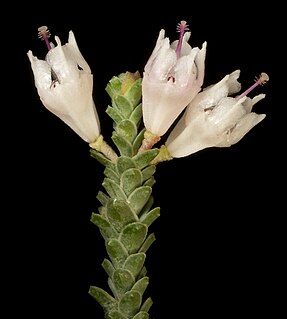
Darwinia pauciflora is a plant in the myrtle family Myrtaceae and is endemic to Western Australia.
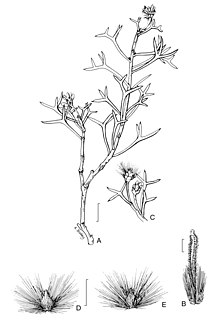
Petrophile pauciflora is a species of flowering plant in the family Proteaceae and is endemic to western areas of Western Australia. It is a shrub usually with three-forked leaves, the lobes sharply-pointed, and spherical heads of small groups of hairy yellow or orange flowers.
Robert J. "Rob" Bates is an Australian botanist, plant collector, and illustrator.
Pultenaea pauciflora is a pea which is endemic to Western Australia. It is a member of the Fabaceae family. There are no synonyms.

Eucalyptus pauciflora subsp. niphophila, commonly known as snow gum, is a small tree or large shrub that is native to a few mountain peaks in eastern Australia. It has smooth bark, glossy green, lance-shaped to egg-shaped or elliptical leaves, flower buds in groups of between nine and fifteen, white flowers and cup-shaped, hemispherical or conical fruit. It differs from other subspecies of E. pauciflora in having more delicate, pedicellate flower buds and smaller leaves.

Eucalyptus pauciflora subsp. pauciflora, commonly known as snow gum, cabbage gum or white sally is a tree or mallee that is endemic to eastern Australia. It has smooth bark, glossy green, lance-shaped, curved or elliptical leaves, flower buds in groups of between nine and fifteen, white flowers and cup-shaped, hemispherical or conical fruit.














